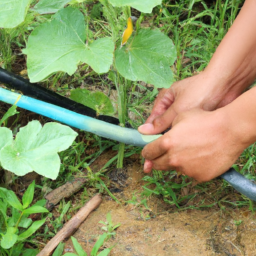How To Soaker Hose Vegetable Garden
Table of Contents []
How To Use Soaker Hose In Vegetable Garden
Introduction
Soaker hoses are essential for sustainable water usage in vegetable gardens. Aside from conserving water, they also release irrigation in a slow, uniform fashion avoiding excess water runoff and allowing the soil to absorb moisture consistently over a period of time. There are several types of soaker hoses and a range of techniques for using them to maintain the ideal moisture level in your vegetable garden. In this article, we look at the benefits of soaker hoses, how to choose a soaker hose, positioning and installation, considerations of timing, and maintenance.
What Are the Benefits of a Soaker Hose?
A soaker hose is a flexible hose with tiny holes that allow water to seep through. This results in minimal water loss via evaporation or runoff and optimal delivery of moisture to the plants. As such, there are many advantages of using soaker hoses to water a vegetable garden, including:
Water efficiency: Soaker hoses save water by ensuring that it is efficiently delivered to plants requiring moisture
Root depth: The water delivery is slow and steady and penetrates deep into the soil, allowing for greater root depth
Soil quality: Soaker hoses allow moisture to be released at an even rate, improving soil quality
Lower water stress: Irrigation is consistent and requires less frequent watering
Easy installation: Soaker hoses are easy to install and remove and require minimal setup
How to Choose a Soaker Hose
When choosing a soaker hose for your vegetable garden, you should consider the diameter, length, puncture resistance, and connection type. Some of the most common Soaker hose types include:
Standard garden hose: This is the most common type of soaker hose with a diameter of inch, puncture resistance, and a solid connection type
Micro-drip: This is a special type of soaker hose designed for small-scale irrigation of potted plants with a diameter of 1/2 inch, puncture resistance, and a special connection type
Multi-layer: This type of soaker hose is designed for large scale irrigation, with a diameter of 3/4 inch, puncture resistance, and a solid connection type
Positioning and Installation
Once you have chosen a hose type, you need to position and install your soaker hose in your vegetable garden. The best way to do this is to start at the highest point in your garden, such as a hilltop or raised bed, and slowly move downwards. You should position the hose so the water will seep into the soil at a consistent rate. To install the soaker hose, you simply need to connect it to the water supply via a regular garden hose. Once the hose is in position and secured in place, you can turn the water on, and the water will begin to seep out of the hose.
Timing and Maintenance
The timing and maintenance of your soaker hose will depend on the specific type and size of your vegetable garden. Generally, it's recommended to water the garden once or twice per week for 15-20 minutes at a time. Remember to check the water supply regularly and clean the hose if necessary, as blocked tiny holes will reduce the efficiency of your soaker hose.
In Summary
Soaker hoses are an effective and efficient way to water a vegetable garden. They provide uniform water delivery which penetrates deep into the soil, reducing water loss via evaporation or runoff while promoting greater root depth and soil quality. When choosing a soaker hose, consider the size, puncture resistance, and connection type. To install the hose, connect it to the water supply via a regular garden hose and then turn the water on. For optimal irrigation, water your vegetable garden once or twice per week for 15-20 minutes at a time. Finally, regularly check and clean your soaker hose to ensure that it is working effectively.

Previous Page
Next Page
